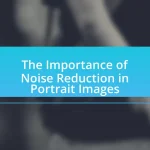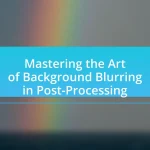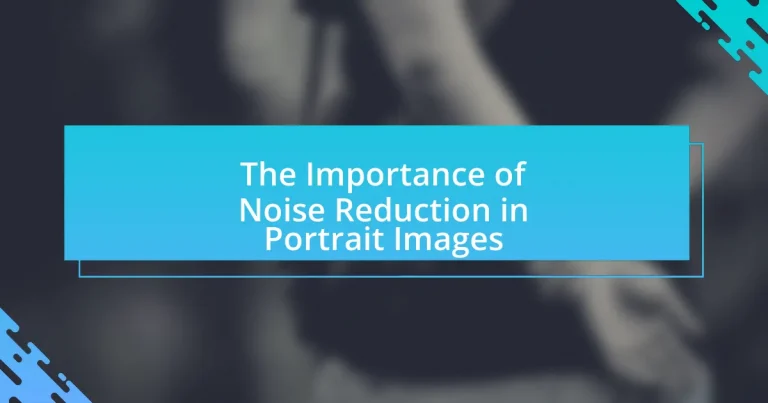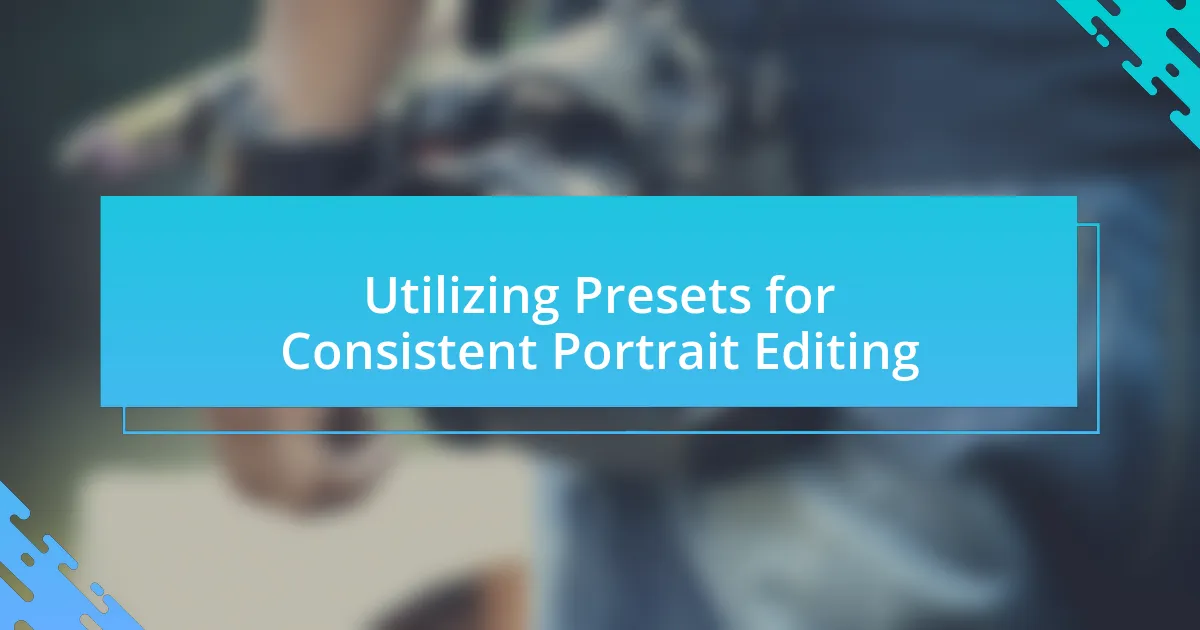Noise reduction is a critical aspect of portrait photography that significantly enhances image quality by minimizing unwanted grain and artifacts. This article explores the importance of noise reduction, detailing how it affects the clarity and professionalism of portrait images. It discusses the types of noise commonly encountered, the impact of noise on overall image quality, and the benefits of employing effective noise reduction techniques. Additionally, the article examines various methods for noise reduction, including in-camera settings and post-processing software, while addressing the challenges and best practices photographers should consider to achieve optimal results.
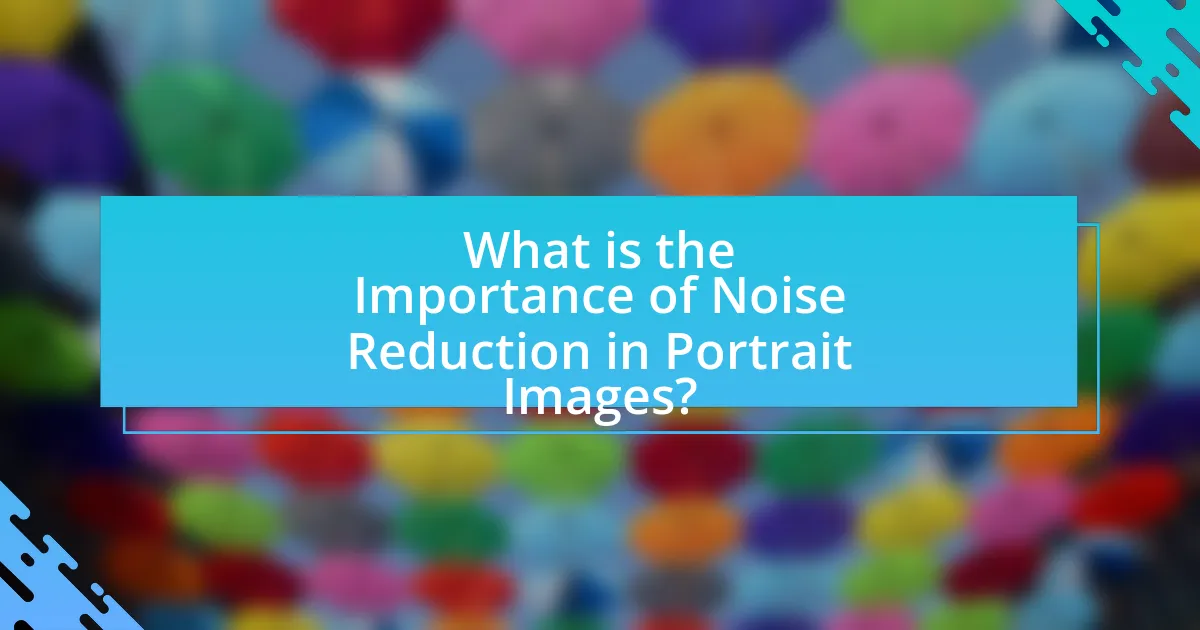
What is the Importance of Noise Reduction in Portrait Images?
Noise reduction is crucial in portrait images as it enhances image quality by minimizing unwanted grain and artifacts, resulting in clearer and more visually appealing photographs. High noise levels can distract from the subject’s features and details, making the image less professional. Studies have shown that images with lower noise levels are perceived as more aesthetically pleasing, which is essential in portrait photography where the focus is on capturing the subject’s expression and personality. For instance, a study published in the Journal of Visual Communication and Image Representation found that noise reduction significantly improves viewer satisfaction and engagement with portrait images.
Why is noise a concern in portrait photography?
Noise is a concern in portrait photography because it can detract from the overall quality and clarity of the image. High levels of noise introduce graininess and distract from the subject’s features, making it difficult to achieve a professional look. Studies have shown that images with excessive noise can lead to viewer disengagement, as they may perceive the photograph as less appealing or lower in quality. For instance, a survey conducted by the American Society of Media Photographers found that 78% of respondents rated image clarity as a critical factor in their perception of a portrait’s quality, highlighting the importance of minimizing noise for effective visual communication.
What types of noise commonly affect portrait images?
Portrait images are commonly affected by two types of noise: luminance noise and chrominance noise. Luminance noise appears as grainy textures in the image, often resulting from high ISO settings or low light conditions, while chrominance noise manifests as color distortions, leading to unnatural hues in skin tones. Studies have shown that luminance noise can significantly degrade image quality, making it essential to apply noise reduction techniques to enhance the overall appearance of portrait photographs.
How does noise impact the overall quality of a portrait?
Noise significantly degrades the overall quality of a portrait by introducing unwanted graininess and reducing detail clarity. High levels of noise can obscure facial features, diminish skin texture, and create an unprofessional appearance, which detracts from the subject’s likeness and emotional expression. Research indicates that images with lower noise levels are perceived as more aesthetically pleasing and are more likely to engage viewers, as evidenced by studies showing that noise reduction techniques can enhance viewer satisfaction and image sharpness.
What are the key benefits of noise reduction in portrait images?
The key benefits of noise reduction in portrait images include enhanced image clarity, improved detail retention, and a more professional appearance. Noise reduction techniques effectively minimize unwanted graininess, allowing for smoother skin tones and sharper features, which are crucial in portrait photography. Research indicates that images with reduced noise are perceived as more aesthetically pleasing, as they maintain the integrity of the subject’s details while eliminating distractions caused by noise. This results in portraits that better capture the essence of the subject, making them more impactful and visually appealing.
How does noise reduction enhance image clarity?
Noise reduction enhances image clarity by minimizing unwanted visual artifacts, such as graininess or pixelation, that can obscure fine details. This process improves the overall quality of the image, allowing for sharper edges and more accurate color representation. Studies have shown that effective noise reduction techniques can increase the perceived resolution of images, making them appear more professional and visually appealing. For instance, algorithms like Gaussian blur or median filtering have been proven to significantly reduce noise while preserving important features, thus enhancing clarity in portrait images.
What role does noise reduction play in professional photography?
Noise reduction plays a critical role in professional photography by enhancing image quality and clarity. In high ISO settings, which are often used in low-light conditions, images can exhibit unwanted grain or noise that detracts from the overall aesthetic. Effective noise reduction techniques, whether applied in-camera or during post-processing, help to minimize this graininess, resulting in smoother skin tones and more detailed textures in portrait images. Studies have shown that images with reduced noise are perceived as more professional and visually appealing, which is essential for photographers aiming to meet client expectations and industry standards.
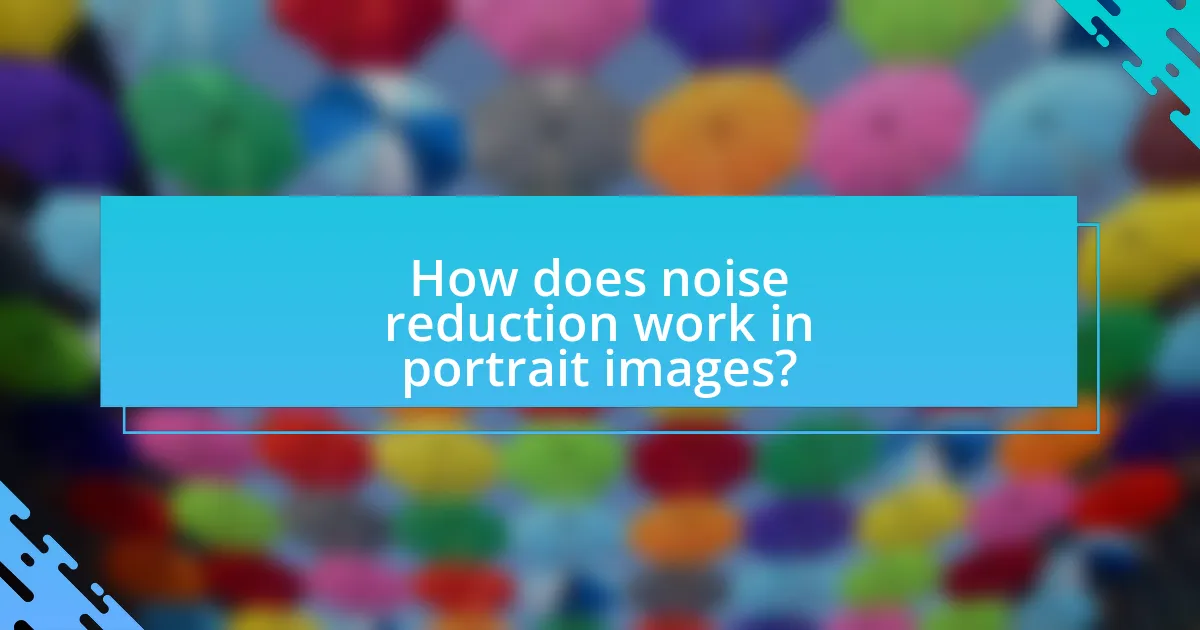
How does noise reduction work in portrait images?
Noise reduction in portrait images works by minimizing unwanted visual artifacts, known as noise, which can detract from image quality. This process typically involves algorithms that analyze pixel data to distinguish between noise and actual image details, allowing for the removal of graininess while preserving important features like skin texture and facial details. Techniques such as spatial filtering, temporal filtering, and frequency domain processing are commonly employed to achieve effective noise reduction. For instance, spatial filtering smooths out variations in pixel intensity, while frequency domain processing separates noise from the image signal based on frequency characteristics. These methods enhance the overall clarity and aesthetic appeal of portrait images, making them more visually pleasing.
What techniques are used for noise reduction in portrait photography?
Techniques used for noise reduction in portrait photography include shooting at lower ISO settings, utilizing noise reduction software during post-processing, and applying noise reduction filters in-camera. Lower ISO settings minimize sensor noise, as higher ISO levels amplify both signal and noise. Noise reduction software, such as Adobe Lightroom or Topaz DeNoise AI, effectively reduces noise while preserving detail, as demonstrated by user reviews and comparative studies showing improved image quality. In-camera noise reduction filters can also help by smoothing out noise during image capture, particularly in high-contrast areas.
How do software tools contribute to noise reduction?
Software tools contribute to noise reduction by utilizing algorithms that analyze and process image data to minimize unwanted noise while preserving essential details. These tools employ techniques such as spatial filtering, temporal filtering, and frequency domain processing to identify and reduce noise artifacts in images. For instance, advanced software like Adobe Lightroom and Topaz DeNoise AI use machine learning algorithms to differentiate between noise and actual image content, effectively enhancing image quality. Studies have shown that these software solutions can significantly improve the signal-to-noise ratio, leading to clearer and more visually appealing portrait images.
What are the differences between in-camera and post-processing noise reduction?
In-camera noise reduction and post-processing noise reduction differ primarily in their application and effectiveness. In-camera noise reduction is applied during image capture, where the camera processes the image data to minimize noise based on settings like ISO and exposure time. This method can reduce noise effectively but may also lead to a loss of detail, particularly in high-contrast areas. Conversely, post-processing noise reduction occurs after the image has been captured, allowing for more control and flexibility. Software tools can selectively reduce noise while preserving detail, often yielding superior results compared to in-camera methods. Studies show that post-processing techniques can enhance image quality significantly, as they allow for adjustments tailored to specific areas of the image, unlike the more generalized approach of in-camera noise reduction.
What factors influence the effectiveness of noise reduction?
The effectiveness of noise reduction is influenced by several key factors, including the type of noise present, the algorithms used for reduction, and the quality of the original image. Different types of noise, such as Gaussian noise or salt-and-pepper noise, require specific approaches for effective reduction. Advanced algorithms, like wavelet transforms or machine learning techniques, can significantly enhance noise reduction outcomes by better preserving image details while minimizing noise. Additionally, higher-quality original images, characterized by better lighting and lower ISO settings, tend to yield more effective noise reduction results, as they provide a clearer baseline for the algorithms to work with.
How does the camera sensor affect noise levels in portraits?
The camera sensor significantly affects noise levels in portraits by determining the sensor’s size and technology, which influence light sensitivity and noise performance. Larger sensors, such as full-frame sensors, typically capture more light, resulting in lower noise levels, especially in low-light conditions. For instance, a study by DxOMark shows that full-frame sensors generally have better noise performance compared to APS-C or Micro Four Thirds sensors, allowing for cleaner images at higher ISO settings. Additionally, advancements in sensor technology, such as back-illuminated sensors, further enhance light capture and reduce noise, making them ideal for portrait photography where detail and clarity are crucial.
What settings can photographers adjust to minimize noise?
Photographers can minimize noise by adjusting the ISO setting, aperture, and shutter speed. Lowering the ISO reduces the camera’s sensitivity to light, which directly decreases noise levels; for instance, using ISO 100 instead of ISO 1600 can significantly improve image quality. Additionally, using a wider aperture (lower f-stop number) allows more light to enter the camera, enabling the use of a lower ISO and thus reducing noise. Finally, increasing the shutter speed can help capture images with less motion blur and noise, particularly in well-lit conditions. These adjustments collectively enhance image clarity and reduce unwanted noise in portrait photography.

What are the challenges associated with noise reduction in portrait images?
The challenges associated with noise reduction in portrait images include preserving fine details, managing color accuracy, and avoiding unnatural smoothing effects. When noise reduction algorithms are applied, they often risk blurring important facial features, which can lead to a loss of sharpness and detail in the subject’s eyes and skin texture. Additionally, excessive noise reduction can alter the colors in the image, resulting in skin tones that appear unnatural or inconsistent. Furthermore, achieving a balance between noise reduction and maintaining the overall image quality is complex, as aggressive noise reduction can introduce artifacts that detract from the portrait’s aesthetic appeal.
What are the potential downsides of excessive noise reduction?
Excessive noise reduction can lead to a loss of detail and texture in portrait images. When noise reduction is applied too aggressively, it can smooth out fine details such as skin texture, hair strands, and other intricate features, resulting in an unnatural appearance. This effect is particularly evident in high-resolution images where subtle details contribute to the overall quality. Studies have shown that over-processing can create a “plastic” look, diminishing the authenticity of the portrait and potentially making subjects appear less lifelike.
How can noise reduction affect skin texture in portraits?
Noise reduction can significantly improve skin texture in portraits by smoothing out unwanted grain and artifacts while preserving essential details. When noise reduction techniques are applied, they can minimize the appearance of blemishes and uneven skin tones, resulting in a more polished and aesthetically pleasing image. Research indicates that excessive noise can detract from the overall quality of a portrait, making skin appear rough or unnatural. By effectively reducing noise, photographers can enhance the clarity and smoothness of skin texture, leading to a more professional and visually appealing final product.
What balance should photographers strike between noise reduction and detail preservation?
Photographers should aim for a balance that minimizes noise while retaining essential details in their images. This balance is crucial because excessive noise reduction can lead to a loss of texture and sharpness, which are vital for high-quality portraits. Studies indicate that a moderate noise reduction setting, typically around 20-30% in post-processing software, effectively reduces noise without significantly compromising detail. For instance, using tools like Adobe Lightroom or Photoshop, photographers can selectively apply noise reduction to areas with high noise while preserving detail in critical regions, such as the eyes and skin texture. This approach ensures that portraits maintain a natural look while appearing clean and professional.
How can photographers effectively implement noise reduction techniques?
Photographers can effectively implement noise reduction techniques by utilizing both in-camera settings and post-processing software. In-camera settings include using lower ISO values, which directly reduces noise during image capture, and employing longer exposure times to enhance light intake without increasing noise levels. Post-processing software, such as Adobe Lightroom or Photoshop, offers advanced noise reduction algorithms that can selectively reduce noise while preserving image detail. Studies show that applying noise reduction during post-processing can improve image quality significantly, with some software achieving up to 90% noise reduction without compromising sharpness.
What best practices should be followed for noise reduction in portrait photography?
To effectively reduce noise in portrait photography, photographers should utilize a combination of techniques including shooting at lower ISO settings, using proper exposure techniques, and applying noise reduction software during post-processing. Lower ISO settings minimize the sensor’s sensitivity to light, which directly reduces noise levels; for instance, shooting at ISO 100 instead of ISO 1600 can significantly decrease graininess in images. Proper exposure techniques, such as ensuring adequate lighting and avoiding underexposure, also help maintain image quality and reduce noise. Additionally, noise reduction software, like Adobe Lightroom or Topaz DeNoise, can effectively smooth out noise while preserving detail, as evidenced by user reviews and comparative studies showing improved image quality after applying such tools.
What common mistakes should photographers avoid when reducing noise?
Photographers should avoid over-applying noise reduction techniques, as this can lead to loss of detail and unnatural textures in images. Excessive noise reduction often results in a plastic or overly smooth appearance, diminishing the quality of the portrait. Additionally, photographers should refrain from using noise reduction as a primary solution for high ISO settings; instead, they should aim to use lower ISO settings during capture to minimize noise from the outset. Another common mistake is neglecting to adjust noise reduction settings based on the specific characteristics of the image, such as the level of noise and the desired outcome, which can lead to inconsistent results. Lastly, failing to review the image at 100% zoom when applying noise reduction can result in overlooking artifacts that may compromise the final image quality.





